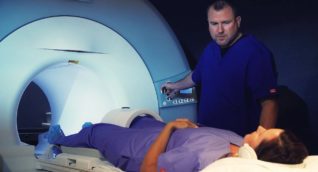About Brain Aneurysm
Throughout the brain there are arteries that supply oxygen-rich blood to the brain. If an artery wall becomes weakened, an abnormal bulge can form, called a cerebral or intracranial aneurysm.
Unfortunately, most brain aneurysms go undetected until they rupture and blood leaks into the space around the brain called the subarachnoid space. Bleeding in the subarachnoid space is called a subarachnoid hemorrhage. Depending on the location and severity of the bleeding, the results can range from a severe headache, to brain damage or even death.
Studies have shown that in the United States approximately 3% to 5% of the population has an unruptured brain aneurysm. The chance of a person suffering an aneurysm rupture is 12 people per 100,000. This results in approximately 30,000 people a year suffering from a ruptured aneurysm.
The outcome of a ruptured aneurysm is often poor. Approximately half of the people who rupture an intracranial aneurysm will die within minutes. Of the 50% who survive, half will suffer a delayed death. Of the 25% who remain, their long-term deficits range from very mild to severe.
If you or someone you know has been diagnosed with an unruptured aneurysm, there are treatment options.
When an aneurysm is discovered (ruptured or unruptured) it must be evaluated to see which treatment option is best. Currently, there are two types of aneurysm treatment options – coiling and clipping.
Coiling of an aneurysm is performed by a neurointerventional surgeon. This procedure is performed by entering the circulatory system through a needle placed in an artery in the leg and using X-rays to guide catheters (small plastic tubes) into the brain. Once there, an even smaller tube called a microcatheter is guided into the aneurysm. Small platinum coils are then carefully placed within the aneurysm to close it. The catheters are then removed, and a small Band-Aid is placed on the leg at the catheter entrance site.
Clipping of an aneurysm is performed by a neurosurgeon. This procedure is performed by an “open” approach involving a skin incision, craniotomy (opening of the skull), retraction of the brain (to reach the aneurysm), and clipping of the aneurysm (placing a small “clothespin-like” clip across the aneurysm neck).
ISAT Trials
A recent international study called ISAT (The International Subarachnoid Aneurysm Trial) was conducted to compare clipping and coiling procedures. The goal of the landmark clinical trial was to enroll 3,000 patients, but the study was halted after only 2,143 patients because coiling showed a clear advantage over traditional neurosurgical clipping. In the ISAT study patients who had ruptured aneurysms were placed into one of two groups: neurosurgical clipping or neurointerventional coiling.
The results showed that on one-year follow-up:
30.9% were deceased or dependent (having severe disability) in the neurosurgical group
23.5% were deceased or dependent (having severe disability) in the neurointerventional group
This represents a 23.9% relative risk reduction and a 7.4% absolute risk reduction by undergoing the neurointerventional coiling procedure.
The overall mortality rates were similar in both groups:
• 10.1% of the people died in the neurosurgical group.
• 8.1% of the people died in the neurointerventional group.
This means that for every 100 patients treated, roughly 7 could expect to be better off in one year if they received neurointerventional treatment as opposed to neurosurgical treatment. The study also looked at the re-bleeding rate of the aneurysms up to seven years and found 0.16% (significantly less than 1 percent) re-bleed rate for the neurointerventional group, and 0% re-bleed rate for the neurosurgical group.
The ISAT study concludes that “In patients with a ruptured intracranial aneurysm, for which neurointerventional coiling and neurosurgical clipping are therapeutic options, the outcome in terms of survival free of disability at 1 year is significantly better with neurointerventional coiling”. This does not mean that all aneurysms should be coiled. There are certain types of aneurysms that are much better treated by a neurosurgical approach, and aneurysms that are much better treated by an neurointerventional approach.
Our surgeons’ personal belief and recommendation is that if you have an unruptured aneurysm, you should be evaluated at a medical center that has both neurosurgical and neurointerventional physicians. Every aneurysm and every patient is unique, and the pros and cons of each procedure should be weighed by the patient before a decision is made.

 Back to Top
Back to Top